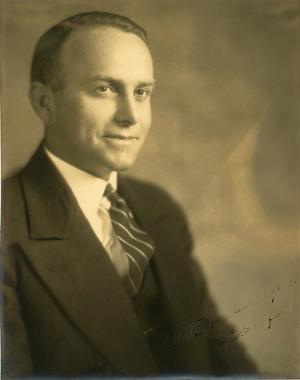It's a common theme in books and movies: historic relics buried in a secret treasure trove underneath a famous monument. Nicholas Cage discovered lost treasure in New York City's Trinity Church in National Treasure; he struck gold again at Mount Rushmore in National Treasure: Book of Secrets. Indiana Jones tore through any number of libraries and museums looking for hidden clues in his treasure hunts. In Night at the Museum: Battle at the Smithsonian, the Institution's treasures were stored in a four story subterranean vault entered through the Castle.
Sometimes truth is stranger than fiction.
I'm a researcher at the Smithsonian Institution Archives, where I have been studying how curators determine the most important or valuable objects in their collections. I've looked at risk management plans because, in any emergency, curators only have time to protect a few choice objects.
A few months ago while looking through the Smithsonian's wartime collections, I stumbled across something surprising that might have been ripped from the pages from a Hollywood script: a plan to build a secret treasure trove underneath a memorial to Supreme Court Justice Oliver Wendell Holmes, Jr.
In the run up to World War II, curators at the Smithsonian and the National Gallery of Art believed that Washington, D.C. would experience aerial bombing much like the city of London faced during the Blitz. The National Resources Planning Board established the Committee for the Conservation of Cultural Resources (CCCR) and charged it with developing a plan for the protection of the federal government's cultural institutions and assets in the event of war.
Archibald MacLeish, then the Librarian of Congress, took the lead in running the CCCR, and one of the projects he pursued was a bombproof shelter. In her history of the CCCR, Jane Aikin tells of a chance encounter between Supreme Court Justice Harlan F. Stone and MacLeish at a White House reception in December 1940, which led to an intriguing plot. Harlan suggested linking the construction of a memorial garden to Supreme Court Justice Oliver Wendell Holmes, Jr. with a hidden underground vault. The two projects together might entice Congress to fund them.
MacLeish ran the idea past Frederic A. Delano, who headed both the National Resources Planning Board and the National Capital Park and Planning Commission. Delano was not in favor of such a construction project, and neither were many elected officials. "It appears that members of Congress who have been consulted regarding a bombproof [shelter] for the preservation of cultural treasures located in Washington do not look with favor on the expenditure of any considerable sum for this purpose," lamented J. E. Graf, Associate Director of the Smithsonian's U.S. National Museum. "It is apparent to me that probably they have not received our concise arguments as to why such a step is necessary or the various difficulties connected with any plan[.]" [see collection RU 483 - Box 1, Folder 1941, 3 of 4]
MacLeish, assisted now by Graf, began a full-fledged campaign to convince Congress and planners of the need for a bomb-proof vault. After surveying Washington cultural institutions, the CCCR came to the conclusion that a minimum of 514,000 cubic feet of storage space was needed. That was larger than the then available floor space of the entire Natural History Museum. Armed with statistics and a need for the "highest degree of protection possible," they again made a pitch for a "bomb-resisting shelter" to W. N. Reynolds, the Commissioner of Public Buildings in 1941. [see collection RU 483 - Box 1, Folder 1941, 3 of 4, 10/7/1941]
MacLeish and Graf were no more successful with their aggregated data or architectural plans that they devised this time around. Agreeing to move the shelter to Suitland, Maryland, the site of the Smithsonian's present storage facilities, did not help their effort. The cost of the building, an estimated $2,000,000 and $5,000,000, proved to be too high.

And the vault underneath the planned Oliver Wendell Holmes, Jr. Memorial became Washington's D.C.'s secret treasure trove that might have been.
For further reading on the CCCR, Jane Aikin, "Preparing for a National Emergency: The Committee on Conservation of Cultural Resources, 1939-1944." Library Quarterly 77, no. 3 (2007): 257-285.
Related Resources
- Collections Storage facility in Shenandoah National Park, Smithsonian Institution Archives
Related Collections
- Record Unit 483, United States National Museum Committee on Conservation of Cultural Resources, Committee Records, 1940-1943, Smithsonian Institution Archives
Produced by the Smithsonian Institution Archives. For copyright questions, please see the Terms of Use.


Leave a Comment